 Creepy
Creepy  Creepy
Creepy  Technology
Technology 10 Scientific Breakthroughs of 2025 That’ll Change Everything
 Our World
Our World 10 Ways Icelandic Culture Makes Other Countries Look Boring
 Misconceptions
Misconceptions 10 Common Misconceptions About the Victorian Era
 Mysteries
Mysteries 10 Strange Unexplained Mysteries of 2025
 Miscellaneous
Miscellaneous 10 of History’s Most Bell-Ringing Finishing Moves
 History
History 10 Great Escapes That Ended Right Back in Captivity
 Weird Stuff
Weird Stuff 10 Fascinating Things You Might Not Know About Spiders
 Food
Food 10 Everyday Foods You Didn’t Know Were Invented by the U.S. Military
 History
History 10 Odd Things Colonial Americans Kept at Home
 Creepy
Creepy 10 More Representations of Death from Myth, Legend, and Folktale
 Technology
Technology 10 Scientific Breakthroughs of 2025 That’ll Change Everything
 Our World
Our World 10 Ways Icelandic Culture Makes Other Countries Look Boring
Who's Behind Listverse?

Jamie Frater
Head Editor
Jamie founded Listverse due to an insatiable desire to share fascinating, obscure, and bizarre facts. He has been a guest speaker on numerous national radio and television stations and is a five time published author.
More About Us Misconceptions
Misconceptions 10 Common Misconceptions About the Victorian Era
 Mysteries
Mysteries 10 Strange Unexplained Mysteries of 2025
 Miscellaneous
Miscellaneous 10 of History’s Most Bell-Ringing Finishing Moves
 History
History 10 Great Escapes That Ended Right Back in Captivity
 Weird Stuff
Weird Stuff 10 Fascinating Things You Might Not Know About Spiders
 Food
Food 10 Everyday Foods You Didn’t Know Were Invented by the U.S. Military
 History
History 10 Odd Things Colonial Americans Kept at Home
10 Moments In The History Of Sacrificial Religious Suicides
Self-immolation is suicide on principle. Religious self-immolation is the ancient practice of sacrificing the body and mind through suicide to make a statement for a cause that one feels deeply about. It’s a burned offering of the entire self.
The practice can be traced back to ancient India but probably predates that. There have likely been suicides as long as humans possessed the means to kill themselves and religious suicides as long as there have been devout religious observers.
Sometimes, self-immolation is purely spiritual. Other times, it’s practical to die with purity and avoid enslavement or torture. In almost all cases, religious suicide is done to prove a point, to send a message loud and clear to the rest of the world that will outlive the one performing the act. Religious self-immolation is martyrdom by one’s own hand.
Here are 10 moments in the history of religious self-immolation.
10 Sati
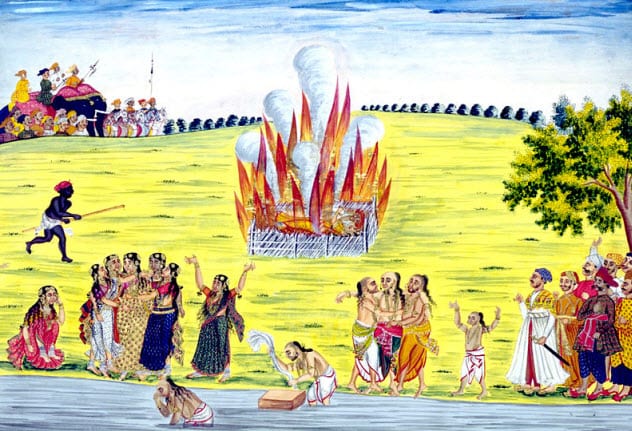
One of the oldest-known myths surrounding self-immolation, suicide as a form of protest, stems from India where religious legend has it that the goddess Sati killed herself to protest a perceived injustice. This goddess married the god Shiva, though her father didn’t approve.
According to Indian mythology, when her father was upset and insulted Shiva, Sati killed herself as a form of protest by setting herself on fire. In some parts of Indian culture, this developed into a legitimate practice called suttee whereby a woman whose husband had died would jump into the flames of his funeral pyre and burn herself alive, thus solidifying their bond in eternity.
This was a sign of extreme devotion to the husband and the religious sanctity of marriage. The word “suttee” or “sati” translates roughly to “good wife” or “chaste wife” and has been traced in documentation to the fourth century BC, which was written about by the Greeks in the first century BC.[1]
9 Jauhar
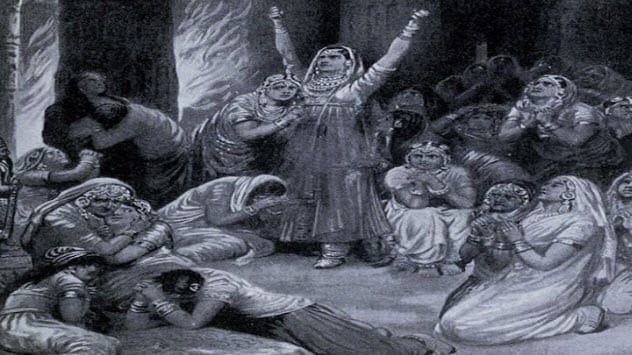
Jauhar is the Indian practice of self-immolation that began a long time ago. It set the stage for many of the facets of self-immolation as we still see the fire method taking place around the world today, particularly in religions which sprang out of India. However it should be noted that self-immolation isn’t limited to the use of fire or Indian religions.
Sometimes, women would burn themselves alive upon hearing that their husbands were not going to return home from battle. Like the chastity of medieval knights and their damsels, Indian culture took saving themselves for one another very seriously and would commit suicide by fire to remain chaste eternally.
The sati was also practical beyond just wives throwing themselves into the funerary flames of their husbands to die together. It was sometimes a means of averting a crisis of religious proportions. The practice became much more widespread in the 14th and 15th centuries as the rise of Islam caused a clash between the cultures of Islam and India.
With this came a lot of battles, and women preferred to kill themselves rather than become captives of Islamic forces. To be raped was one of the most horrible offenses to not only the culture at the time but also the various religions of India. It was considered better to kill yourself than to suffer at the hands of religious oppressors. These women would also light themselves on fire to evade their captors and avoid being taken alive.[2]
8 Diodorus of Sicily

Diodorus of Sicily was a Greek writer and historian who lived in the first century BC and mentions the practice of self-immolation in his literature. In this first-known account of sati, Diodorus tells the story of Hieronymus of Cardia, which is believed to have been a self-immolation which took place in or around 326 BC.[3]
In the description, a man named Ayamani of Guntur died and his wife decided to thrust herself into the afterlife with him. However, Ayamani had two wives. Thus, a fight ensued over who would be the one privileged enough to go into death with him. A woman named Pustika ended up being victorious, and the remains of their corpses were later discovered resting together.
7 Suicide Sacrifice
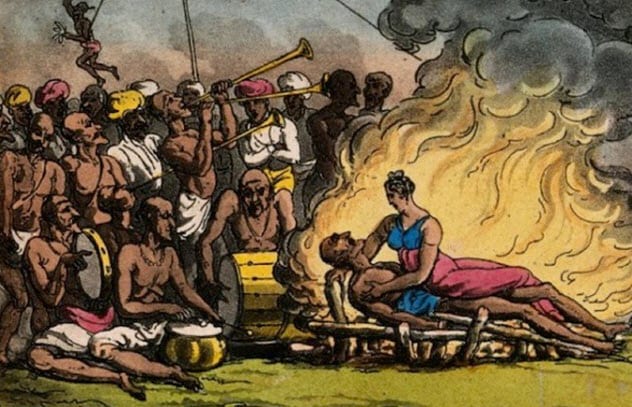
In the various Indian religions, ambiguity surrounds the origins of self-immolation, especially as to just how voluntary it’s been through the ages. While largely championed as a sacrificial suicide done of volition, this has been increasingly brought into question.
There are bizarre reports of faith healer–type miracles that are supposed to take place around sati immolations where the audience is healed of all sorts of different diseases. This means that the reporting of events surrounding various self-immolations in history is questionable.
Further complicating the question is the fact that society, especially groups of people hoping to receive some form of religious blessing in the way of miracles, might actively try to coerce a woman into ritualistic suicide in hopes of receiving some reward.
If that’s the case, is a coerced suicide really an act of volition? Is there such a thing as an obligatory suicide? Often, while the very hand that carried out a sati was the one who was self-immolating, the rest of the work was done for them. All they needed to do was light the pyre, sometimes with the threat of force urging them to kill themselves.[4]
The other aspect of the involuntary nature of sati is that women whose husbands had died were considered unable to marry again. It was often against social customs and sometimes even against the law.
6 Execution
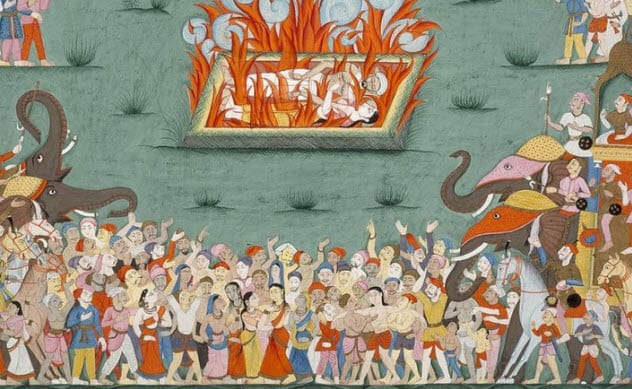
Tragically, the history of self-immolation is also rife with instances of what could be likened to a public execution. However, it was not of a criminal but of a woman guilty of simply being married to an honorable man who had died. Supposed “self-immolation” has also been a practice of a mob executing a woman to somehow honor the man she was married to until his death.
Often, the pyre built to burn the body of the husband was designed to be inescapable. Women were locked into the pyres, and a family member lit the woman and her husband’s dead corpse on fire. Throughout the history of self-immolation, there’s been an extremely thin line between suicide and murder.
As people have escaped sati, it appears to have been an involuntary practice at times and points to the killing of an innocent person in a socially acceptable way rather than an actual suicide.[5]
5 Cultures Clash
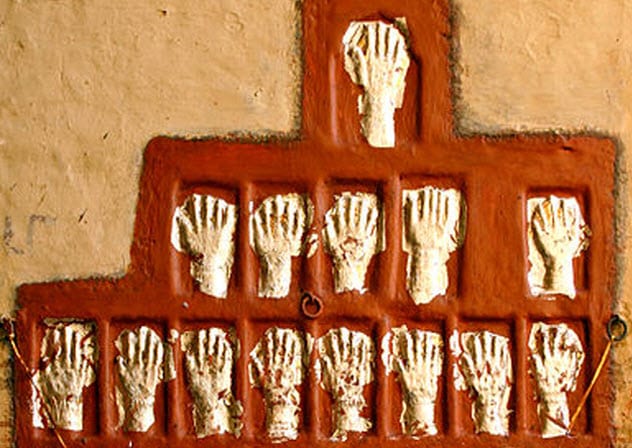
As the worlds of the East and West became more entangled, self-immolation in a group setting became highly scrutinized by Western colonists as they became increasingly dominant in the Eastern world. Today, we’re stuck with teasing out the reality of the history of self-immolation. Have the cultures that have long killed themselves for religious reasons misrepresented the reality of the practice, or have Western writers retold the tales in ways that might be biased due to a lack of understanding?
One thing is certain. Over time, self-immolation spread from India and its religions to become a global phenomenon despite the domination of Western civilization. When India was a colony of Great Britain, the practice of self-immolation was outlawed entirely.[6]
However, with its deeply embedded religious tradition, this was met with some backlash. Thus, people continued to kill themselves in the name of religious protest or sacrifice.
4 Christian Self-Immolation

Self-immolation isn’t wholly a practice of the Eastern world. It has roots in Western religion tracing all the way back to early Christianity. During the Roman Empire, Christian martyrdom sometimes used suicide to achieve its ends.
In an era of being members of a minority religion, many Christians committed crimes knowing for certain that they would be executed by the powerful Roman state. Much like suicide-by-cop today, early Christians sought to intentionally get themselves executed as a form of martyrdom because Christianity is rife with the belief of purification through death. Pope Urban II and many other prevalent Christian figures considered self-immolation in the name of Christian beliefs to be an automatic ticket to Heaven.
Judas was a major figure in Christian history who also committed suicide after becoming anguished about his betrayal of Christ, who himself was a martyr. Both instances led thousands of Christians to take their own lives to be like these two men. It wasn’t until more recent times—after Shakespeare at least—that suicide became taboo in Christian culture. Beforehand, suicide and intentional martyrdom were often thought of as highly noble acts of virtue.[7]
According to many scholars, the major distinction here is that true martyrdom must be an involuntary act. In contrast, early Christians willingly and gladly marched to their executions, hoping for their golden ticket to Heaven. As we will see, self-immolation and martyrdom have always been deeply intertwined.
3 Thich Quang Duc
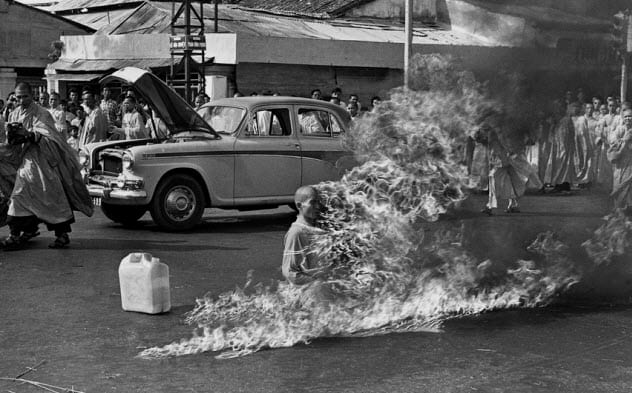
One of the most iconic photos of all time is of a man named Thich Quang Duc in Saigon, Vietnam, in 1963, sitting with his legs folded, completely engulfed in flames. Thich Quang Duc’s sacrificial act remains the most infamous religious suicide of all time and took place in protest against the government of South Vietnam.
This further solidified self-immolation as a noble act in today’s world. Even the US President John F. Kennedy remarked on its powerful message as the world caught a glimpse of the photo back then.
The regime in South Vietnam had implemented some drastic, anti-Buddhist policies and tried to adopt a pro-Catholic approach even though South Vietnam was then comprised of 70–90 percent Buddhists. Thich Quang Duc made his decision, and his choice was clear: In order for a message to be communicated and to try to stop the oppression of the Buddhists in South Vietnam in 1963, he had to take to a highly public place and light himself on fire.
And that’s exactly what he did. This act brought about a resurgence of sacrificial suicides, ushering in a modern era of taking one’s own life. It was often done as a public spectacle for a cause of deep meaning and value to the individual willing to trade his life for it.[8]
2 Roop Kanwar
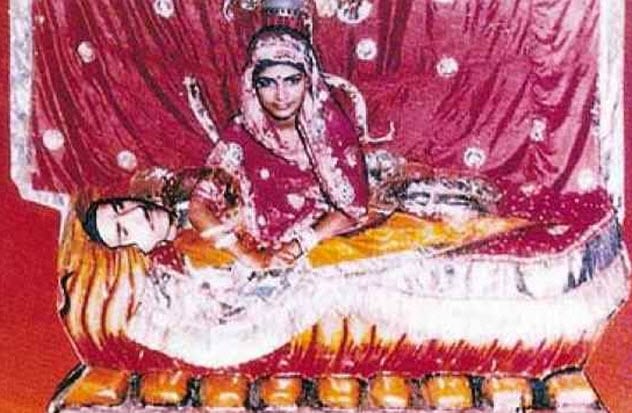
Even though self-immolation had been outlawed in India under British occupation in 1829, the practice continued. One of the more recent instances was the possible sacrificial suicide (or possible murder) of a woman named Roop Kanwar in 1987. In stark contrast to Thich Quang Duc, the death of Roop Kanwar reminds us that not all cases of self-immolation are cut-and-dried. Ambiguity around religious suicide remains even today and can sometimes be used as a pretext for murder.
Kanwar had married a man who would end up dying just eight months after their wedding. In her small village of Deorala, India, self-immolation was apparently still a thing. She had considered practicing sati. But she backed out at the last minute rather than kill herself ritualistically in front of thousands.
After that, authorities became suspicious of the circumstances and conducted an investigation, only to find out that men had drugged her and forcibly coerced her into the act of sacrificial suicide. This poor woman was forced into killing herself in a supposed religious rite by the society around her.[9]
1 New Millennium Suicide
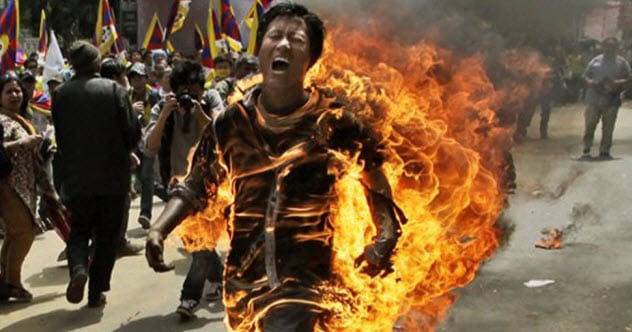
The new millennium hasn’t seen a slowing down in self-immolation. In the computer age, people across the globe still practice sacrificial suicides and probably will for a long time considering its effectiveness in conveying a message to the public. Tibetan Buddhists of the 20th and 21st centuries have been committing suicide for decades to protest Chinese rule, and they show no signs of slowing down anytime soon.[10]
In 2011, Tibetan nun Palden Choetso took to the streets, lit herself on fire to protest the Chinese, and tried to captivate the world and make them question the political situation in Tibet. Shocking videos of this incident exist online as it was filmed by students who believed that Tibet should be free and independent of Chinese rule.
Religious suicide in the name of a cause has actually become a catalyst for many historical events today. For example, Arab Spring was triggered when a vendor in Tunisia decided to kill himself in the streets of Sidi Bouzid in 2010. This caused a ripple effect of people tired of state and religious corruption and domination, which helped set the Arab Spring in motion. Self-immolation cases in Tunisia had tripled by 2016.
As media and recording become more accessible in our world, so do the widespread effects of sacrificial suicide in the name of a cause. Today, someone can commit suicide on video while the whole world watches it live. Their cause doesn’t die with them but is given a breath of new life.
Read more about creepy religious suicides on 10 Creepy And Bizarre Suicides and 10 Dark Mysteries Involving Strange Cults.








